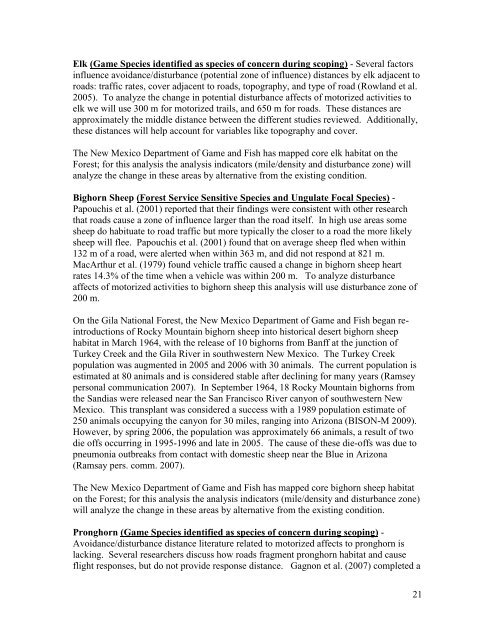Wildlife Specialist report
Wildlife Specialist report
Wildlife Specialist report
You also want an ePaper? Increase the reach of your titles
YUMPU automatically turns print PDFs into web optimized ePapers that Google loves.
Elk (Game Species identified as species of concern during scoping) - Several factors<br />
influence avoidance/disturbance (potential zone of influence) distances by elk adjacent to<br />
roads: traffic rates, cover adjacent to roads, topography, and type of road (Rowland et al.<br />
2005). To analyze the change in potential disturbance affects of motorized activities to<br />
elk we will use 300 m for motorized trails, and 650 m for roads. These distances are<br />
approximately the middle distance between the different studies reviewed. Additionally,<br />
these distances will help account for variables like topography and cover.<br />
The New Mexico Department of Game and Fish has mapped core elk habitat on the<br />
Forest; for this analysis the analysis indicators (mile/density and disturbance zone) will<br />
analyze the change in these areas by alternative from the existing condition.<br />
Bighorn Sheep (Forest Service Sensitive Species and Ungulate Focal Species) -<br />
Papouchis et al. (2001) <strong>report</strong>ed that their findings were consistent with other research<br />
that roads cause a zone of influence larger than the road itself. In high use areas some<br />
sheep do habituate to road traffic but more typically the closer to a road the more likely<br />
sheep will flee. Papouchis et al. (2001) found that on average sheep fled when within<br />
132 m of a road, were alerted when within 363 m, and did not respond at 821 m.<br />
MacArthur et al. (1979) found vehicle traffic caused a change in bighorn sheep heart<br />
rates 14.3% of the time when a vehicle was within 200 m. To analyze disturbance<br />
affects of motorized activities to bighorn sheep this analysis will use disturbance zone of<br />
200 m.<br />
On the Gila National Forest, the New Mexico Department of Game and Fish began reintroductions<br />
of Rocky Mountain bighorn sheep into historical desert bighorn sheep<br />
habitat in March 1964, with the release of 10 bighorns from Banff at the junction of<br />
Turkey Creek and the Gila River in southwestern New Mexico. The Turkey Creek<br />
population was augmented in 2005 and 2006 with 30 animals. The current population is<br />
estimated at 80 animals and is considered stable after declining for many years (Ramsey<br />
personal communication 2007). In September 1964, 18 Rocky Mountain bighorns from<br />
the Sandias were released near the San Francisco River canyon of southwestern New<br />
Mexico. This transplant was considered a success with a 1989 population estimate of<br />
250 animals occupying the canyon for 30 miles, ranging into Arizona (BISON-M 2009).<br />
However, by spring 2006, the population was approximately 66 animals, a result of two<br />
die offs occurring in 1995-1996 and late in 2005. The cause of these die-offs was due to<br />
pneumonia outbreaks from contact with domestic sheep near the Blue in Arizona<br />
(Ramsay pers. comm. 2007).<br />
The New Mexico Department of Game and Fish has mapped core bighorn sheep habitat<br />
on the Forest; for this analysis the analysis indicators (mile/density and disturbance zone)<br />
will analyze the change in these areas by alternative from the existing condition.<br />
Pronghorn (Game Species identified as species of concern during scoping) -<br />
Avoidance/disturbance distance literature related to motorized affects to pronghorn is<br />
lacking. Several researchers discuss how roads fragment pronghorn habitat and cause<br />
flight responses, but do not provide response distance. Gagnon et al. (2007) completed a<br />
21
















